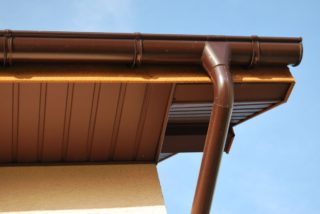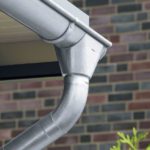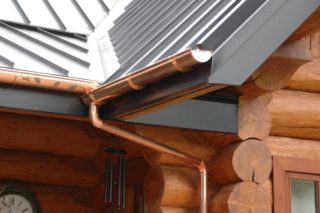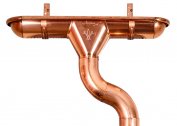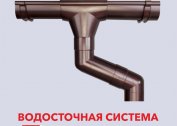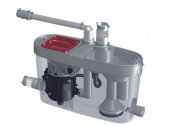If you leave a new or renovated house without a drain, sooner or later the walls, foundation, attic will lose their appearance. Perhaps in the attic, mold will start and more investment will be required. Repair or construction can be considered completed when the gutter system is installed and operational.
Purpose of drainpipes
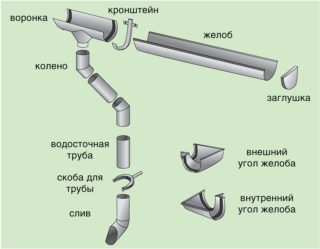 Drainage pipes and storm sewers are needed for the safety of load-bearing structures. Prolonged ingress of moisture under the foundation can cause destruction of concrete or brick. With increased humidity, the soil sags and cracks appear in the walls. In winter, the water in the soil freezes and increases in volume - this also contributes to the distortion of the structure. If underground communications are located near the house - water supply or sewage, ice causes deformation of the material, up to cracking.
Drainage pipes and storm sewers are needed for the safety of load-bearing structures. Prolonged ingress of moisture under the foundation can cause destruction of concrete or brick. With increased humidity, the soil sags and cracks appear in the walls. In winter, the water in the soil freezes and increases in volume - this also contributes to the distortion of the structure. If underground communications are located near the house - water supply or sewage, ice causes deformation of the material, up to cracking.
In winter, ice forms on the slopes of the roof, which during the thaw can crash down and injure people. Additional insulation of the gutters with an electric cable reduces the risk of icicles falling, as meltwater flows into the sewers.
If the walls are insulated with mineral wool or other energy-saving materials, the ingress of water can cause them to spoil, as a result of which they will no longer be able to perform their functions. Damage to the finishing materials is possible: stains, chips and damage to the color of the paint, no matter how resistant it is. Facade tiles may collapse due to water entering between the seams.
Classification by section shape and other parameters
Gutters are distinguished by the following parameters:
- production material - galvanized steel, copper, plastic, metal-plastic, aluminum, wood;
- form - round, square.
All elements of the drainage system are made of the same material so that there are no deformations due to the different index of thermal expansion. Materials can be selected at an affordable price. It is important to provide for the average rainfall in the region, since the size of the gutters will depend on this.
Plastic gutters
Plastic in drainage systems is often used because of its low cost. In this case, it is possible to choose the color and shape of the gutters and other structural elements. Plastic pipes do not rust and do not change color over time.
Due to their light weight, they are easier to install, and they do not create a load on the building facade. Special attachment devices make assembly easy.
In addition to the advantages, there are also disadvantages:
- unprotected plastic quickly loses its characteristics under the influence of ultraviolet radiation;
- improperly selected materials in improvised structures can crack in the cold, since not all types of plastic are resistant to low temperatures;
- deformations occur during sudden changes in temperature.
Polymers can break under mechanical stress - falling branches or stone.
Galvanized steel
Galvanized steel drain pipes are installed in the private sector and industrial enterprises. Such systems are inexpensive, but have disadvantages. First of all, they are susceptible to corrosion, so you can not count on a long service life. The zinc coating is erased over time due to debris, hail, ice. Unprotected steel begins to oxidize, and a drain flows through the holes formed.
Aluminum
Aluminum is one of the lightest metals that are used in the construction of drainage systems. It does not rust due to the oxide film formed on the surface.Aluminum gutters are sometimes coated with water-repellent material to reduce the damaging effects of moisture. On sale you can find galvanized aluminum with a water-repellent coating. Such products last a long time and do not lose their attractive appearance.
Wood
Wooden drains are installed on houses from timber, so as not to spoil the overall impression of the style. At the same time, a hardwood tree is selected and treated with various chemicals from mold, insects. Over time, wood drains lose their appearance and require restoration or replacement.
- Wood
- Steel
- Alubinium
Copper
Copper gutter systems - this is the most expensive solution for a private house, but they serve for a long time. Over time, copper is coated with an oxide film and changes color. Sometimes when ordering the material is artificially aged to get the desired shade - patina.
Copper does not rust, does not create a lot of noise when water passes through the gutter structure, ultraviolet radiation does not have any negative effect. Theoretically, the material is suitable for use up to 300 years. In order for the products to withstand the indicated period, plasma welding is used, sheet copper of a certain thickness and quality is used.
Combined systems
Metal-plastic gutters - a good solution in terms of quality and price. They can withstand a long service life, as they consist of a metal sheet, sheathed with plastic on both sides. As a metal, inexpensive galvanized steel is usually used. Plastic frost-resistant with protection from sunlight.
Metal-plastic constructions for private houses are chosen for several reasons:
- Appearance of products - you can choose for any color of walls and roofs;
- plastic with metal - a more durable combination than just a polymer product;
- You can order ready-made systems according to customer size.
Metal-plastic drainage systems are assembled quickly and do not require experience. For installation under the roof, you will need to additionally mount mounting clamps on the walls.
Dimensions of gutters
The dimensions of the details of the drainage system are selected based on the average annual rainfall, as well as the roof area. Crucial is the depth and width of the gutter. For it, you can choose the following sizes:
- the width of the tray should be 100 mm, the diameter of the drainpipe is 75 mm, if the roof area is less than 50 square meters;
- tray width 150 mm, pipe 90 mm, if the area is up to 100 square meters. m;
- if the roof area is more than 150 square meters. m, the tray should be up to 200 mm wide and the pipe diameter up to 120 mm.
In addition to gutters and pipes, funnels, brackets for attaching the gutter under the roof, clamps for attaching pipes to the wall, elbows for draining water into the storm sewer are included in the gutter system. Plugs and corners are calculated depending on the configuration of the roof.
Calculation of the number of downspouts
To begin with, they are determined with the number of risers. In ordinary houses there are at least 4. If there are extensions, they are also taken into account. Then the distance from the roof to the ground is measured and this number is multiplied by the number of risers.
Next, the length of the gutters is calculated. To do this, measure the perimeter of the house and extensions. The number of funnels is determined by the number of angles, but can be set according to another scheme. For example, in the center of the wall and in the corners. In this case, it will be necessary to take into account the slope of the gutters so that they direct water to the funnels. This is important in the winter, as ice in the gutters can ruin the coating or cause cracking of the material. If one side of the perimeter is too long, it makes sense to install another riser with an additional funnel in the middle.
Installation Steps
 Installation of the drainage system is carried out first under the roof - brackets are installed. From the edge of the roof to the edge of the gutter should be at least 3 cm. This is necessary so that water does not spray. The first bracket is mounted in the middle of the wall.Further along the corners so that the bias towards the funnels is observed. For convenience, it is better to pull a rope or fishing line.
Installation of the drainage system is carried out first under the roof - brackets are installed. From the edge of the roof to the edge of the gutter should be at least 3 cm. This is necessary so that water does not spray. The first bracket is mounted in the middle of the wall.Further along the corners so that the bias towards the funnels is observed. For convenience, it is better to pull a rope or fishing line.
After the gutters are laid and the edges are polished (if the drain is made by hand), you can proceed to the installation of risers:
- The vertical pipe is inserted into the funnel.
- Clamps are attached to the wall and the pipe is crimped, but not much, since in the heat the materials expand and can deform the wall. The pipe must move freely inside the clamp.
- Installing elbows may be required to drain fluid into a storm sewer.
So that the joints do not diverge, during operation it is recommended to lubricate them with sealant and degrease them before application. It is better to mount the structure in the warm season. At sub-zero temperatures, materials behave differently, especially polymeric ones.
During installation, the number of brackets must be correctly calculated. If they are not enough, the structure may sag and break.
To check how the gutter system works, you need to direct a hose with water into the gutters and see if there are any leaks. In the autumn, before the onset of cold weather, it is necessary to clean the gutters from leaves and falling debris so that they do not clog the pipes and storm sewers.
The cost of drains
The cheapest is a gutter system made by yourself from galvanized steel or plastic pipes. Such work requires time and tools. You also need to know which polymer is most suitable for the manufacture of a drain, how it will function in winter.
The price of plastic drainpipes combined with steel is slightly higher. Such designs are usually bought ready-made and quickly installed under the roof.
The most expensive gutters are copper. Here, the pricing is affected by the cost of the material itself and welding, which are performed at a plasma jet temperature of about 6000 degrees. This method allows you to get outwardly smooth joints without distortions and scale.
The more material goes into the manufacture of the entire system and additional parts, the higher the total cost of the finished structure. The price also includes fixing materials - screws, screws, nails.
